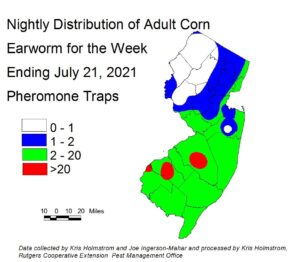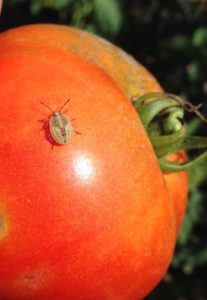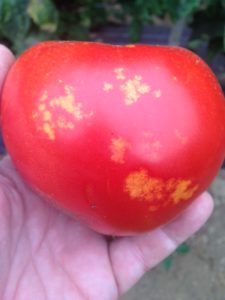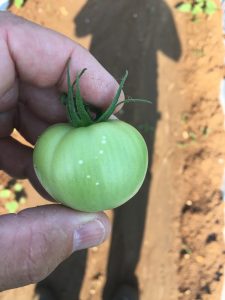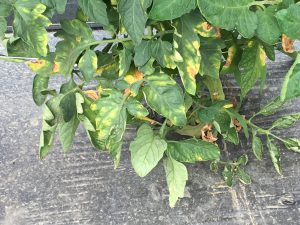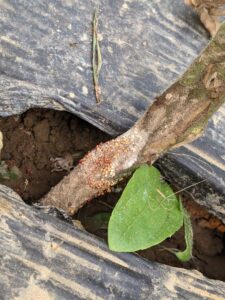Sweet Corn
European corn borer (ECB) moth catches continue to be extremely low around the state. We are in between adult generations at this time. ECB population maps will resume if second flight catches rise to high enough numbers.
The highest nightly trap catches of ECB for the week ending 07/21/21 are as follows:
| Centerton 1 |
| Milford 1 |
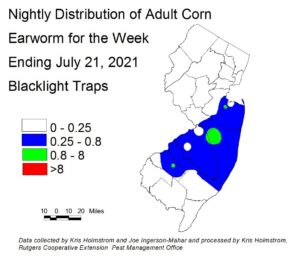 Corn earworm (CEW) moths captures from blacklight traps remain low, but pheromone trap captures have increased to varying degrees in parts of the state. These elevated pheromone catches have primarily occurred in the southern Burlington-Gloucester County region. North Carolina trap catches have risen recently, although trapping activities there have begun fairly recently, and Delaware catches are in range with New Jersey. Generally we see our larger influx of CEW adults after the first week of August. However, given the duration of elevated temperatures this year, it is best to anticipate a somewhat earlier “hot season” for CEW. Check this publication weekly for CEW status. The number of pheromone traps deployed is much lower, resulting in much broader color bands on the map. It is also important to understand that pheromone traps are more sensitive than blacklight traps, and thresholds are adjusted to account for the higher catches typical of this trap type. Silking corn is at risk of CEW infestation at this time. On the blacklight map (left), green areas represent a 3-4 day silk spray schedule and blue represents a 4-5 day schedule. On the pheromone map (below right), red represents a 3 day spray schedule, green represents a 4-5 day schedule, and blue represents a 5-6 day schedule. Be sure to access information from this publication in the upcoming weeks to determine how frequently you should treat silking sweet corn to protect it from CEW infestation.
Corn earworm (CEW) moths captures from blacklight traps remain low, but pheromone trap captures have increased to varying degrees in parts of the state. These elevated pheromone catches have primarily occurred in the southern Burlington-Gloucester County region. North Carolina trap catches have risen recently, although trapping activities there have begun fairly recently, and Delaware catches are in range with New Jersey. Generally we see our larger influx of CEW adults after the first week of August. However, given the duration of elevated temperatures this year, it is best to anticipate a somewhat earlier “hot season” for CEW. Check this publication weekly for CEW status. The number of pheromone traps deployed is much lower, resulting in much broader color bands on the map. It is also important to understand that pheromone traps are more sensitive than blacklight traps, and thresholds are adjusted to account for the higher catches typical of this trap type. Silking corn is at risk of CEW infestation at this time. On the blacklight map (left), green areas represent a 3-4 day silk spray schedule and blue represents a 4-5 day schedule. On the pheromone map (below right), red represents a 3 day spray schedule, green represents a 4-5 day schedule, and blue represents a 5-6 day schedule. Be sure to access information from this publication in the upcoming weeks to determine how frequently you should treat silking sweet corn to protect it from CEW infestation.
The highest nightly blacklight trap catches of CEW for the week ending 07/21/21 are as follows:
| New Egypt 2 | Farmingdale 1 | Old Bridge 1 |
| Allentown 1 | Folsom 1 | Springdale 1 |
| Cinnaminson 1 | Medford 1 | Tabernacle 1 |
| Downer 1 | Morristown 1 | Woodstown 1 |
The highest nightly pheromone trap catches of CEW for the week ending 07/21/21 are as follows:
| Pedricktown 43 | Beckett 13 | Crosswicks 9 |
| Tabernacle 41 | East Vineland 13 | Green Creek 8 |
| Monroeville 31 | Eldora 13 | Berlin 7 |
| Elm 14 | Woodstown 13 | Dayton 2 |
Silking Spray Schedules*:
South – 3-4 days
Central – 4-5 days
North – 6 days
*These recommendations are based on regional catches. Adhere to tighter spray schedules if indicated by local trap catches. Synthetic pyrethroids alone should NOT be used for corn earworm (CEW) protection on silking corn, or for fall armyworm (FAW) management at any stage. Control with these materials is very inconsistent. Utilize materials in IRAC groups 5 and 28, or combination products that include IRAC group 28 for best control. See the Sweet Corn section of the 2020-21 Commercial Vegetable Production Guide for selections.
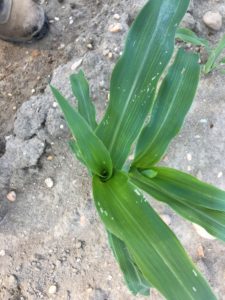
 Fall armyworm (FAW) larval infestations have been detected in all parts of the state except the northernmost counties. So far, infestation levels have been very low. However, this is the time of the summer when FAW can show up, resulting in significant injury to whorl and even seedling stage corn. Injury from newly hatched larvae shows up as “window panes” or areas where leaf tissue has been eaten down the the lower epidermis (see photo at far left). This injury leads down into the whorl. As larvae gain size, they begin to consume leaf tissue in its’ entirety, creating ragged holes and lots of droppings (see photo at near left). FAW can be tough to manage because it is resistant to synthetic pyrethroid insecticides (IRAC 3A) and because larvae are often covered by their own droppings, making contact with the insecticide more difficult. Treat when 12% or more plants exhibit FAW injury alone, or in combination with ECB injury. As a rule, insecticides that are most effective on CEW will also adequately control FAW.
Fall armyworm (FAW) larval infestations have been detected in all parts of the state except the northernmost counties. So far, infestation levels have been very low. However, this is the time of the summer when FAW can show up, resulting in significant injury to whorl and even seedling stage corn. Injury from newly hatched larvae shows up as “window panes” or areas where leaf tissue has been eaten down the the lower epidermis (see photo at far left). This injury leads down into the whorl. As larvae gain size, they begin to consume leaf tissue in its’ entirety, creating ragged holes and lots of droppings (see photo at near left). FAW can be tough to manage because it is resistant to synthetic pyrethroid insecticides (IRAC 3A) and because larvae are often covered by their own droppings, making contact with the insecticide more difficult. Treat when 12% or more plants exhibit FAW injury alone, or in combination with ECB injury. As a rule, insecticides that are most effective on CEW will also adequately control FAW.
Tomatoes
As we move through July, brown stink bug injury is increasing. These true bugs (see photo of Euschistus sp. nymph below at left), move into irrigated tomato fields as forage in the surrounding environment dries out. Feeding results in “cloudy spot” (see photo at right below). Increases in stink bug injury are often found by crews picking the fruit. Growers should consider 1-2 insecticide applications to limit fruit injury if this damage is increasing in harvested fruit. If actively scouting fields, insecticides should be considered if stink bug adults, nymphs or new fruit injury is found in 2 or more sample sites in a 10 site sample. Insecticides that are effective on stink bugs include pyrethroids and neonicotinoids, so care should be taken to avoid contact with foraging bees.
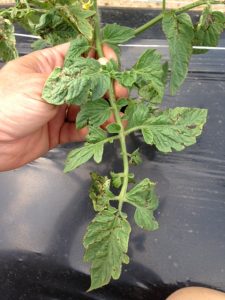 With wet weather now dominant, bacterial leaf spot (BLS) and bacterial canker symptoms have become increasingly common in tomato plantings. BLS lesions (photo at right) are small and very dark. Lesions may appear on foliage of any age, and when immature foliage is infected, lesions will prevent normal expansion, resulting in distorted leaves. Bacterial canker lesions (photos at lower right) on foliage often first appear as chlorotic triangles at the margins of lower leaves. These areas become necrotic and eventually entire leaves die. Canker lesions on fruit are white blisters on the surface of green fruit, and are quite characteristic. Care should be taken when working in plantings exhibiting symptoms of bacterial infections. Always work in younger plantings before older ones to avoid introducing pathogens to younger plants. Pruning, tying or harvesting when foliage is wet will spread these diseases. When tying, it may be useful to place containers of 5% bleach solution at the ends of rows in which to dip the tying wands. This may help limit spread between rows.
With wet weather now dominant, bacterial leaf spot (BLS) and bacterial canker symptoms have become increasingly common in tomato plantings. BLS lesions (photo at right) are small and very dark. Lesions may appear on foliage of any age, and when immature foliage is infected, lesions will prevent normal expansion, resulting in distorted leaves. Bacterial canker lesions (photos at lower right) on foliage often first appear as chlorotic triangles at the margins of lower leaves. These areas become necrotic and eventually entire leaves die. Canker lesions on fruit are white blisters on the surface of green fruit, and are quite characteristic. Care should be taken when working in plantings exhibiting symptoms of bacterial infections. Always work in younger plantings before older ones to avoid introducing pathogens to younger plants. Pruning, tying or harvesting when foliage is wet will spread these diseases. When tying, it may be useful to place containers of 5% bleach solution at the ends of rows in which to dip the tying wands. This may help limit spread between rows.
Southern blight has been found on a few farms in the scouting program this season. This fungal disease (Sclerotinia rolfsii) causes rapid wilting and death of plants. Inspection of the main stem at the soil line reveals the presence of numerous spherical structures (sclerotia) adhering to the stem (see photo at right – courtesy of Rhea Bolar). This disease is relatively uncommon in NJ, especially in northern counties, but exceptionally hot conditions with high soil moisture are contributing to it’s appearance. Little can be done once it appears. Tomatoes should be avoided in fields with a history of this disease. Future plantings may be treated with the PCNB fungicide, Blocker in the transplant water. See the Tomato Section of the 2020-21 Commercial Veg. Recs. for details.
Peppers
Pepper weevil – Traps continue to be deployed, and we have still captured no weevils in pheromone traps. We are not aware of any fields having infestations. We normally find the most infestations in August. That we haven’t trapped any weevils is a good thing. A new fact sheet is now available for anyone interested in monitoring for pepper weevils on their own: FS1330: Monitoring and Management of Pepper Weevil in New Jersey (Rutgers NJAES).
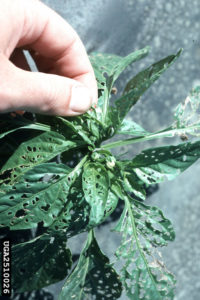 Low numbers of beet armyworm adults (BAW) continue in southern NJ pheromone traps. As yet, no reports of feeding by this pest have surfaced. However, growers in Gloucester, Salem and Cumberland counties should monitor pepper fields weekly for signs of feeding. BAW larvae feed in the developing foliage in terminal growth of plants. Initially, leaves are skeletonized (photo at left, courtesy of Univ. of Ga.), but as larvae grow, they will move onto fruit and damage these as well. As with other armyworms, BAW is difficult to control with pyrethroid insecticides. Effective materials include spinosyns (IRAC 5) and diamides (IRAC 28).
Low numbers of beet armyworm adults (BAW) continue in southern NJ pheromone traps. As yet, no reports of feeding by this pest have surfaced. However, growers in Gloucester, Salem and Cumberland counties should monitor pepper fields weekly for signs of feeding. BAW larvae feed in the developing foliage in terminal growth of plants. Initially, leaves are skeletonized (photo at left, courtesy of Univ. of Ga.), but as larvae grow, they will move onto fruit and damage these as well. As with other armyworms, BAW is difficult to control with pyrethroid insecticides. Effective materials include spinosyns (IRAC 5) and diamides (IRAC 28).
Pumpkins and Winter Squash
Cucurbit downy mildew (CDM) is active on cucumbers in all parts of the state, and is infecting cantaloupes in southern NJ at this time. As yet, other cucurbits, including pumpkins, butternut squash, acorn squash and watermelons are unaffected. Recent wet weather favors CDM, and disease incidence on affected crops may worsen significantly under these conditions. For regional information on this important disease, see the Cucurbit Downy Mildew Forecast webpage: http://cdm.ipmpipe.org/. This forecast has NJ at moderate-to-high risk of further infection through Tuesday 7/13. It is advisable that all growers treat preventively for CDM on cucumbers and muskmelons. As yet, there have been no reports in the region of CDM affecting any other cucurbit crops. This is important, as pumpkins and winter squash are now active crops in the region.
Cole Crops
 Recent hot weather (with prolonged periods of high nighttime temperatures) have resulted in leaf tip burn in many cole crops, both leafy types (kale, collards) and heading types like cabbage and cauliflower (see photo at left – courtesy of Rhea Bolar). This condition is similar to blossom end rot in tomatoes and peppers in that it is the result of inadequate supply of water (and thus calcium) to rapidly growing tissues. This is not a disease. While recent weather may make some of this unavoidable, it may be possible to mitigate it somewhat by maintaining steady soil moisture during hot, breezy spells of weather.
Recent hot weather (with prolonged periods of high nighttime temperatures) have resulted in leaf tip burn in many cole crops, both leafy types (kale, collards) and heading types like cabbage and cauliflower (see photo at left – courtesy of Rhea Bolar). This condition is similar to blossom end rot in tomatoes and peppers in that it is the result of inadequate supply of water (and thus calcium) to rapidly growing tissues. This is not a disease. While recent weather may make some of this unavoidable, it may be possible to mitigate it somewhat by maintaining steady soil moisture during hot, breezy spells of weather.
Brown marmorated stink bug (BMSB)
BMSB trap catches remain very low. No map will appear in this addition.
